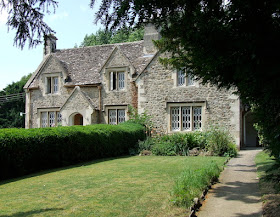Thursday, March 17, 2016
Coleshill, Berkshire*
Looking at Coleshill again (2)
Starting to think again about the lost country house of Coleshill reminded me about one thing especially that struck me about the place. As Karen Fielder says in her essay, although the house itself has gone, the estate still exists.† As well as the gate piers in my previous post, the many interesting architectural remains include a model farm, a dovecote, a walled kitchen garden, and a number of cottages.
Of course thousands of English cottages once formed part of country estates. They were built to house workers on the farms and those who maintained the house and serviced the estate in all kinds of ways. While household servants would live in, in the attic rooms of the big house itself, workers in other areas – from the fields to the carpenter’s shop – would have had cottages. Such estate houses often follow the prevailing architectural style of the area, but sometimes they have distinctive features that mark them out as special, something that shows that they belong to the estate – a special design of porch, say, ornate bargeboards, or a particular paint shade.
Glazing bars with fancy patterns are sometimes such a defining feature, and this seems to be the case at Coleshill. Perhaps it’s because cottage builders liked such glazing patterns in the late-18th and early-19th centuries and this was when many estates were ‘improved’ by their landlords, who built better housing for their workers and adopted modern farming techniques too. Coleshill has several houses with these lovely windows glazed in hexagonal and diamond-shaped panes (along with others that have plainer square panes). The way the masonry is set off with details in ashlar (smoothy worked blocks of stone) at the corners and around the windows is another sign that some care and expense was taken with the houses in the picture. Without such details, buildings like these would look like fairly standard Cotswold houses (Coleshill is near the edge of the Cotswolds, where the hills yield to the flat country around the Thames) but the details set them apart.
The 3rd Earl of Radnor (1779–1869) was a notable improver of the Colshill estate. I think that these cottages were built by him in around 1850; they look larger than many cottages, especially the one on the left, but seem to display the estate style and would have been among numerous beneficial changes made during the earl’s long life. Karen Fielder says that the appearance of the village today owes much to his efforts. Not all 19th-century landlords provided such good housing, but it looks as if some at least of the people of Coleshill were fortunate. As are we, able to pick up clues about their past in the appearance of some fancy glazing bars from perhaps 160 years ago.¶
- - - - -
*I use the ‘historic’ English counties because of a sentimental attachment to them and because they are used by the Pevsner Buildings of England series.
†Karen Fielder, ‘X marks the spot: narratives of a lost country house’ in Jon Stobart and Andrew Hann (eds), The Country House: Material Culture and Consumption (Historic England, 2016)
¶A friend reminds me that Coleshill was also the home of the great record producer George Martin, who died recently. RIP.

No comments:
Post a Comment